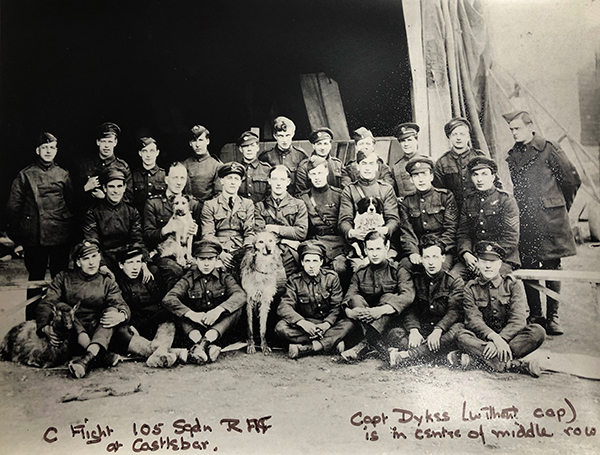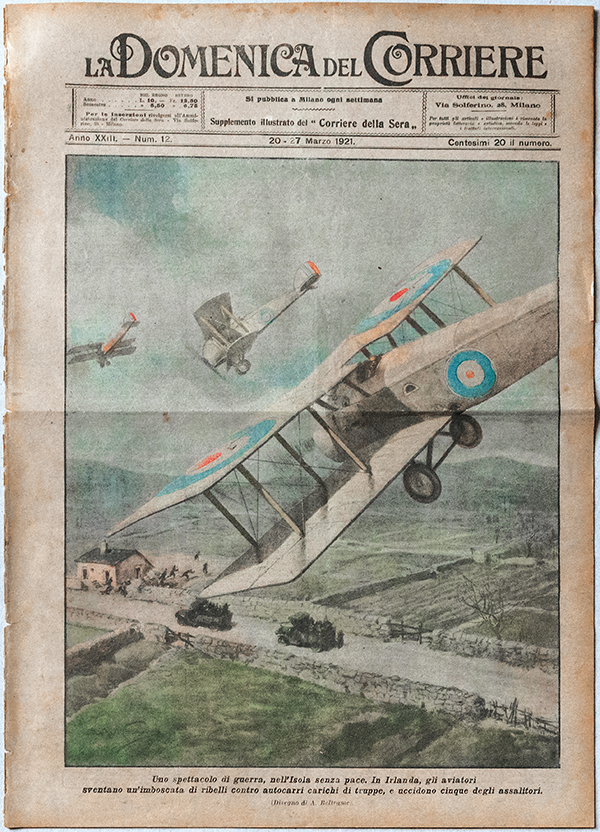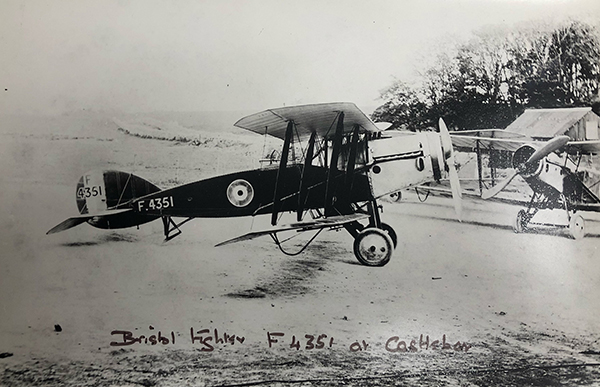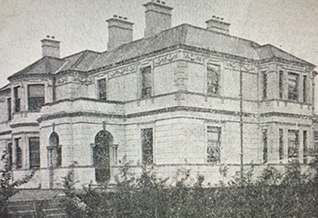THE ROYAL AIR FORCE IN WEST MAYO 1918–21
Published in Features, Issue 1 (January/February 2022), Volume 30by Myles Mac Evilly
During the First World War 23 airfields and airship stations were developed on the island of Ireland, one of which was in Castlebar, Co. Mayo. By the time the Royal Air Force became active in Mayo during the War of Independence, it had already been employed in a close air-support role with the British Army in Munster, flying out of Fermoy airfield over highly contested areas of IRA actions in Cork and Kerry.
To support the different airfields, 60 emergency landing-sites were also created throughout the country on the grounds of the landed gentry, at or near a military or RIC barracks and marked with a large cross. One such RIC barracks was in Balla, Co. Mayo, where a ring of whitewashed stones 15ft in diameter was laid in the garden to guide aeroplanes as they dropped mail and weighted canvas message bags.
DEPLOYMENT
In May 1918, C-Flight (consisting of six RE8 biplanes) from 105 Squadron at Strathroy aerodrome, Omagh, Co. Tyrone, was deployed to Castlebar in a policing role, as well as on anti-submarine reconnaissance along the west coast. In February 1920 it was disbanded and reconfigured as 2 Squadron at Oranmore, Co. Galway (105 Squadron would later add an emerald-coloured battleaxe to its badge to commemorate its service in Ireland).

Above: C Flight, 105 squadron, RAF, at Castlebar. They had been deployed there from Strathroy aerodrome, Omagh, Co. Tyrone, in May 1918. Their commander, Capt. Dykes (centre of the middle row, without cap), led one of the first engagements to fly over Castlebar and Westport in late March 1921.
Six months before, in August 1919, two additional RAF Squadrons, 2 and 100, had arrived in Ireland under the ‘Defence of Ireland Scheme’ (a comprehensive plan devised in October 1918 by the British government in anticipation of a German invasion or a generalised rising). Seven flights from each squadron (all flying F2B fighters by late 1920) were stationed at different airfields, such as Omagh, Castlebar, Oranmore, Fermoy and others, although not all were active at the same time. Each airfield held the prefix ‘RAF’, adhering to the tradition of naming RAF airfields after the nearest railway station (e.g. ‘RAF Castlebar’). Each RAF squadron was legally accountable to the British Army and these squadrons were the first dedicated to a formal army co-operation role, supporting the sizeable British garrison in Ireland, which would increase from 53,000 in May 1919 to 83,000 by July 1921.
Poor serviceability of existing aeroplanes was a constant problem, as outlined in 100 Squadron’s war diary for March 1921, which reported that three aircraft patrols in support of ground infantry ‘rounding up IRA’ in the Ballinrobe area had to be abandoned owing to engine trouble. The end of the First World War saw a rapid downsizing of the RAF in manpower and equipment. Many skilled aviation personnel were demobbed or sent abroad to other colonial hot spots, and some volunteered to serve with the Auxiliaries in Ireland, where the pay and allowances were better. (Five of the Auxiliaries killed at Kilmichael in November 1920 were former members of the RAF.)

Above: An Italian Sunday newspaper depicts a fictitious attack by the RAF in Ireland: ‘The airmen foil an ambush by [IRA] rebels on trucks loaded with troops, killing five of the assailants’. Many foreign newspapers at the time followed British ‘spin’. (La Dominica del Corriere, 7 March 1921)
On arrival in Ireland, the RAF was faced with such problems as poor supply and maintenance of aircraft, communications difficulties and inadequate co-operation between the army and RAF commanders. At the time, Lloyd George refused to allow aeroplanes in Ireland to use machine-guns or bombs, deeming their use to be potentially indiscriminate and disproportionate. This relegated the RAF countrywide to a transport, reconnaissance and communications role up to March 1921 .
Gradually the role of the RAF in the south and east began to expand. Under pressure from Churchill and Sir Hugh Trenchard (later first chief of the air staff), additional aeroplanes were provided. Because road travel was both time-consuming and dangerous, the RAF was active in transporting VIPs about the country, though not always with success. A Major Henry Francis Chad MC, 2nd Battalion, Border Regiment, was killed in a failed landing at RAF Castlebar in August 1920 as he returned from Dublin, having given evidence against the Freeman’s Journal over an incident near Castlebar at Turlough village involving a military lorry. In time, road convoys were escorted by the RAF, especially if senior officers were involved, as happened with Major-Gen. Jeudwine, British commander in the midlands and Connaught, for whom in April 1921 an aeroplane from 100 Squadron at Castlebar was sent to find and escort his delayed armoured-car convoy. Aerial reconnaissance of roads and railways for potential IRA sabotage or ambushes became the norm, as well as the dropping of propaganda leaflets, advising the younger members of the IRA not to be ‘misled’.
By March 1921 the RAF had adopted a more aggressive posture against the IRA and was given permission by the cabinet to use machine-guns and bombs. An RAF liaison officer was deployed to each brigade HQ for advice on reconnaissance, while air-to-ground communications technology and aerial photography were improving.

Above: Bristol fighters at RAF Castlebar during the War of Independence.
THE AERODROME FIELD IN CASTLEBAR

Above: Marylands House, close to Castlebar railway station, where RAF flying officers were billeted, half a mile from the airfield.
An airship station was initially proposed by the RAF for an existing landing-strip at Castlebar, but this plan was later altered to an advanced aerodrome or forward landing-ground for anti-IRA operations. ‘RAF Castlebar’, located north of the Castlebar to Breaffy road, was designated ‘6th Brigade Station’ on the Secret Ordnance Map 120. Known locally as the ‘aerodrome field’, it was on grass within an area of 90 acres, with wooden huts for stores and portable timber and canvas Bessonneau hangars for aeroplanes. A firm of local contractors laid down an apron of granite stones and loose chippings in front of the hangars. A runway of sorts was developed but the ground surface was always soft. Mains water was piped from the nearby town but there was no electricity. A workshop lorry engine generated 110 DC volts of light after 10pm. Aviation fuel tanks with a capacity of 4,000 gallons were installed. Critical for operational reasons, RAF Castlebar had its own wireless station but no telephone system until the end of 1921, relying until then on the local RIC, who possessed their own countrywide telephone system. Both personnel and aeroplanes were subject to the inclement west of Ireland weather, suffering severe damage to aircraft in one extreme winter storm. Ground-support personnel lived in wooden huts and canvas tents on the airfield. Flying officers were billeted in Marylands House, close to the town’s railway station and half a mile from the airfield.
INTENSIFICATION OF THE WAR IN THE WEST
John Charles Milling, a resident magistrate in Westport, had often expressed strong anti-IRA opinions. On the night of 29 March 1921 he was killed at his home by a unit of the local IRA. After the RAF in Castlebar was informed by the RIC, the OC of the 2nd Battalion, Border Regiment, in Castlebar requested the RAF to carry out a flyover ‘to show the flag’. With five RE8 aeroplanes, Capt. Dykes led C-Flight in one of its first engagements, flying over Castlebar and Westport on the day after the killing, letting off bursts of machine-gun fire over Westport from the on-board Lewis gun and dropping 20lb bombs into nearby Clew Bay, all without incident.
The intensification of the war in Munster compelled the IRA leadership to persuade other areas to become more active in an effort to draw British Army men and resources away from the south. One such area was west Mayo, which, although having a strong republican tradition going back to 1798, was slow to engage with the enemy, mainly on account of lack of weapons, especially ammunition.
The West Mayo Brigade did not become a functionally active unit under its OC, Michael Kilroy, until late in the War of Independence, and only then with the formation of the flying column in spring 1921. On top of the shortage of weapons, Kilroy now faced a battle-hardened British Army with the RAF in close aerial support.
By 1921, and embracing operational skills refined in Munster, the RAF adopted a more active role against the West Mayo Brigade. Any military activity by the IRA resulted in an immediate pursuit by aeroplanes from RAF Castlebar, as occurred after the ill-fated Kilmeena ambush and the Skerdagh affray afterwards. Michael Kilroy later described how, after these engagements, ‘a huge operation was mounted by the police and military using aeroplanes with carrier pigeons flying around the whole Nephin range in North Mayo to create awe and consternation among the people’. He had successfully led his column to safety after a night-time march through enemy lines, but five Volunteers lay dead after Kilmeena and one after Skerdagh. Two weeks later, Kilroy led one of the most successful ambushes of the War of Independence at Carrowkennedy on 2 June 1921. Seven RIC officers were killed and six wounded, and a considerable quantity of arms and equipment was captured. Ernie O’Malley later wrote that the RIC and Auxiliaries waited until the following morning to approach and tend to their wounded at Carrowkennedy—a site that had been surveyed by aeroplanes from Castlebar. Afterwards, the nearby mountainous area towards Leenane and Killary Harbour was searched for the retreating column based on information relayed to the RAF pilots by the British Army on the ground via Morse code. Five weeks later, just as the Truce was declared (11 July 1921), General Macready said that he had almost cornered the biggest ‘murder gang’ in the west of Ireland. In reality, despite the involvement of 3,000–5,000 RIC and soldiers in this massive ‘surge’, with aeroplanes flying overhead continuously from Castlebar and Oranmore airfields, and with searchlight-bearing destroyers in Killary Harbour lighting up Croagh Patrick, the flying column escaped capture once more.
ASSESSMENT
By the end of the War of Independence air power had evolved as an important part of British strategy in Ireland. RAF Castlebar, although an ancillary airfield, was very much part of this, as was evident after the Tourmakeady, Kilmeena and Carrowkennedy ambushes. By July 1921 there was better integration between the army and the RAF, as well as better wireless communications and better reconnaissance, whether armed, visual or photographic. In addition, after March 1921 the RAF had carte blanche to use their on-board weapons at will, though no shots were ever fired directly at the IRA. Not widely acknowledged, the lessons learned by the RAF in Ireland were subsequently further refined in colonial ‘policing’ actions elsewhere and were incorporated as written doctrine in subsequent British war manuals. As Richardson observed, ‘the IRA did not fear destruction from the air so much as detection’. Later, Michael Brennan, IRA OC of East Clare, noted that ‘the addition of [more] aeroplanes and armoured lorries would have made short work of us’.
Cadres of 2 and 100 Squadrons continued to fly out of Castlebar until the Truce, when they were transferred to Baldonnel (now Casement) aerodrome. Following a petition by Michael Collins to General Macready at the outbreak of the Civil War, their evacuation was delayed until 14 October 1922.
Dr Myles Mac Evilly is a retired consultant anaesthetist and comes from Castlebar.
Further reading
D. Richardson, ‘The Royal Air Force and the Irish War of Independence 1918–1922’, Air Power Review 19 (3) (2016).
W. Urquhart-Dykes, Reminiscences 1917–1919 of a pilot flying with the RFC in 1919 in what is now the Irish Republic (Leeds, 1999).
















